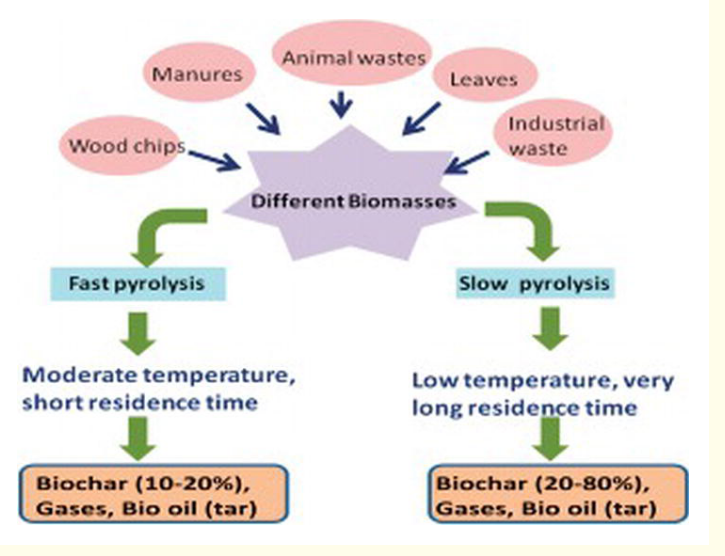
Actually, soil is the main source of everything where microflora and many nutrients are present. Due to the constant increase in population and the presence of excessive chemical fertilizers in agricultural land, the quality of the soil is decreasing, so the need for biochar is immense to increase the production of agriculture and maintain its continuity in order to create a sustainable system. Biochar is a solid carbon-rich material obtained through the pyrolysis process using various organic materials, so I briefly describe the properties of biochar, its interaction with soil microflora, and its role in promoting plant growth when added to the soil.
Table of contents
Introduction
Biochar production and properties
Biochar as a soil amendment
Stimulation of soil microflora and plant growth
Mixing biochar with other amendments
Conclusion
Introduction
Crop growth and productivity are strongly affected by soil quality and pests, weeds, drought, high salinity, temperature, etc. Soil is contaminated with heavy metals through various human activities affecting plant growth and development and even reducing crop yields.
Soil strength is dependent on the availability of soil nutrients. Plants require nutrients such as nitrogen (N), phosphorus (P), and potassium (K) for growth. After the first harvest, soil nutrient levels decrease over time because nutrients are no longer returned to the soil. In many regions of our country, micronutrients such as (Boron, Zinc, Copper, and Iron) are not deficient, but some secondary nutrients such as sulfur, calcium, and magnesium are deficient. To compensate for this deficiency in the soil, large amounts of fertilizers are required but only a small fraction of the water soluble nutrients are absorbed by plants and the rest is converted into insoluble forms which necessitates continuous fertilization. Finally, the widespread use of chemical fertilizers begins to degrade the environment and thereby reduce the nutrient composition of crops and reduce soil fertility in the long term.
In addition to fertilizers, pesticides have adverse effects on agricultural land as they slowly destroy the soil’s microbial properties. This effect of fertilizers and pesticides affects the soil microflora which results in soil health. Coarse bacterial and fungal organic matter is reduced at a significant rate. As a result of long-term soil application with inorganic fertilizers or organic fertilizers, we observe changes in soil structural properties and dominant bacterial groups in agricultural soils. On the other hand, organic fertilizers can improve soil fertility and revitalize the soil, so sustainable methods can be a powerful tool for agriculture. The use of biochar can be accepted as a sustainable method and a promising way to improve soil quality and remove heavy-metal pollutants from soil.
We know that biochar is a by-product of biomass by a process called pyrolysis, which essentially co-produces oil and gas with biomass heating in the complete or near complete absence of oxygen. A report states that biochar obtained from the carbonization of organic waste can be adopted as an alternative because it changes the physicochemical and biological properties of soil.
The potential for farm-based renewable energy generation through biochar in an eco-friendly manner is high. Since biochar contains both organic matter and nutrients, its addition increases soil pH, electrical conductivity, and cation-exchange capacity. The use of this biochar can reduce the risk of soil compaction. We already know about the benefits of rhizobacteria inoculation in soil. Adding biochar benefits agricultural crops by providing more nutrients to the soil.
Biochar is an effective method to remediate currently polluted soils as a positive effect and it can achieve high crop yields without harming the natural environment. So we need to adopt biochar as a viable strategy to improve the farm-scale nutrient cycle.
Biochar production and properties
Biochar is a thermal mixture of organic matter produced during pyrolysis in an oxygen-limited environment and contains elements such as hydrogen, oxygen, sulfur, and nitrogen as well as minerals such as ash. This stable biomass is mixed with soil to combat soil erosion, improve crop productivity, and reduce pollution.
We can make biochar using rice bran, wheat straw, cow dung, grass, wood chips, cassava rhizome, and other agricultural materials as raw materials of biochar. Again using modern pyrolysis method various materials such as crop residues, fertilizers, wood residues, residual organic matter like forest and green wastes, agricultural wastes like bark, straw, husks, bagasse, sawdust, nuts, husks, wood shavings, animal bedding, various Substantial improvements can be made by producing biochar from various types of bark, various stalks and industrial wastes (bagasse, distiller’s grains, etc.), and municipal wastes. In this way, it will be possible to improve waste management.
Commercial feedstocks currently include tree bark, crop residues such as nut shells, straw and rice hulls, hay, and organic wastes including distillers grains, bagasse from the sugarcane industry, chicken litter, dairy manure, sewage sludge, and paper sludge.
We know that biomass is mainly composed of cellulose, hemicellulose, and polymers. Of these, cellulose is the main component of most plant-derived biomass, but lignin is derived from woody biomass.
Modified stoves or kilns can be used for low-cost biochar production, but large-scale production requires pyrolysis plants and large amounts of feedstock. During this time, oil and gas are produced as by-products. To produce large quantities of biochar, the obtained dry waste is first cut into smaller pieces of less than three centimeters before being used. The feedstock is heated to 350–700°C without oxygen or with little oxygen. Fast pyrolysis usually requires temperatures above 500°C to maximize bio-oil production. Slow pyrolysis, on the other hand, usually takes 30 minutes to completely pyrolyze the feedstock. In this case, the temperature is 250-500°C.
The biochar thus produced depends on two factors one is the biomass and the other is the temperature and heating rate. It was found that biochar produced at low temperatures formed less aromatic carbon than biochar produced at high temperatures. The process of pyrolysis has greatly affected the quality of biochar and its potential value in agriculture in terms of agricultural efficiency. Here the process of pyrolysis is shown as follows:
Biomass(Solid)→Biochar+Liquid or oil(tars,water,etc.)+Volatile gases(CO2,CO,H2)BiomassSolid→Biochar+Liquid or oiltars,water,etc.+Volatile gasesCO2,CO,H2

Biochar is a stable form of carbon that persists in soil for thousands of years. It is produced for incorporation into soil as a means of sequestering carbon and improving soil quality. Therefore, pyrolysis conditions and materials used can significantly affect the properties of biochar. Here are some physical properties of biochar
- When biochar is used as a soil amendment, it stimulates soil fertility and increases soil pH, increasing moisture-holding capacity.
- Attracts beneficial fungi and other microbes, and improves cation exchange capacity.
- Conserve soil nutrients by improving soil quality.
- Reduces soil density and soil hardness, and increases soil aeration and cation-exchange capacity.
- It also helps to restore degraded soil.
- It is able to stop hazardous materials in soil.
The effect of biochar on soil physical properties directly affects plant growth, since the depth and permeability of air and water penetration into the root zone is largely determined by the physical structure of the soil horizon. It affects soil response to water, its ability to work in consolidation and soil preparation, mobility and permeability during swelling, as well as response to changes in ambient temperature and cation retention capacity. Biochar increases the availability of C, N, Ca, Mg, K, and P to plants, as biochar absorbs fertilizers and releases them slowly. It helps prevent manure leaching and leaching by allowing less fertilizer use and reducing agricultural pollution to the surrounding environment. Biochar reduces the impact of hazardous pesticides and complex nitrogen fertilizers from the soil, thus reducing the impact on the local environment.
Biochar increases soil microbial respiration by creating space for soil microbes and consequently increases soil biodiversity and soil density. The biochar also served as a host for hyphae of additional radical fungi that spread into micropores due to less competition from saprophytes and therefore served as an inoculum for arbuscular mycorrhizal fungi.
Biochar as a soil amendment
There are two aspects that make biochar amendment superior to other organic materials: the first is its high stability against erosion, so that it can remain in the soil for a long time, which provides long-term benefits to the soil, and the second is its greater ability to hold the soil.
Another valuable property of biochar is the suppression of greenhouse gas emissions in soil. methane and nitrous oxide emissions are reduced from agricultural soils, which may have additional climate mitigation effects, as they are potent greenhouse gases. Different biochar concentrations ranged from 2 to 60% (w/w), suppressed nitrous oxide production above 20% (w/w), and reduced carbon dioxide production through ambient methane oxidation at all levels Above the untreated soil.
Some studies have shown that pathogen control is possible through the use of biochar in agricultural soils. Biochar is effective against both airborne (eg Botrytis cinerea and various species of powdery mildew) and soil-borne pathogens (eg Rhizoctonia solani and Fusarium and Phytophthora species). A study on bacterial wilt control in tomatoes showed that biochar derived from municipal organic waste reduced disease incidence in soils infected with Ralstonia solanacearum. Biochar and biochar-amended compost are recommended for the control of soil-borne bacterial and fungal diseases. The disease suppression mechanism has been attributed to the presence of calcium compounds, as well as to the improvement of physical, chemical, and biological properties of the soil.
Biochar amendment has increased soil fertility and crop production, especially in low-nutrient soils. However, the application of biochar with fertilizers can improve plant growth, but sometimes a negative effect is also observed without fertilizers due to reduced bioavailability through the absorption of nitrogen. Application of biochar to soil has been shown to have positive to neutral or even negative effects on crop production. Therefore, it is important to understand the mechanisms of action of biochar in soil before applying it.
The effect of biochar addition on plant productivity depends on the amount added. Recommended application rates for any soil amendment should be based on extensive field testing. Therefore, it is necessary to control the rate of biochar application to prevent the negative effects of biochar.
Stimulation of soil microflora and plant growth
Some reports say that biochar stimulates soil microflora resulting in greater soil carbon sequestration. Biochar can provide a habitat for bacteria, actinomycetes, and fungi in addition to absorbing nutrients, organic matter, and gases. Applying biochar to the soil increases the water-holding capacity of the soil. Although the interaction of biochar with soil microorganisms is a complex process, biochar provides a suitable habitat for a large and diverse group of soil microorganisms. Some studies show that supplementation of aeration with phosphate solubilizing fungal strains promotes the growth and yield of Vigna radiata and Glycine max plants.
Biochar increases mycorrhizal growth in clover bioassay plants by providing the conditions necessary to strengthen plant roots, and the remaining four mechanisms by which biochar can affect mycorrhizal fungal function are:
Changes in soil chemical and physical properties.
Indirect effects on mycorrhizae through contact with other microbes located in the soil.
Interference and detoxification of toxic chemicals in plant-fungal signaling biochar.
Mushrooms provide shelter from browsers.
Adding biochar to the soil for growing carrots and beans in those areas with steep slopes and soil pH below 5.2 significantly improves. Because the biological N2 fixation (BNF) of Phaseolus vulgaris increased due to greater availability of micronutrients after biochar application. According to management practices, when using both biochar and mycorrhizal fungi, it is possible to use potential synergisms that can positively affect soil quality.
Single application of biochar to non-cropped agricultural products such as maize and beans significantly increased the yield of plants which remained unchanged in the 2nd and 4th year.
For soil nutrition, the direct beneficial effects of adding aeration to soil are mainly due to the high content of potassium, phosphorus, zinc, and to a lesser extent calcium and copper. Some studies show that biochar reduces the need for fertilizers, thereby reducing emissions from fertilizer production, and reducing agricultural waste. Biochar also reduces methane levels due to the natural decomposition of waste.
Mixing biochar with other amendments
Soil efficiency can be improved by mixing biochar with manure, and compost into the soil before using it. Since biochar has been used to fix nutrients and protect against leaching, mixing biochar can improve the efficiency of fertilizers and other amendments. A test has been conducted
Co-composted biochars have greater plant growth-promoting effects than biochar when used pure, but there have been no systematic studies to understand the interactive effects of biochars with non-pyrogenic amendments. Benefits are available. A potential lower loss of nitrogen gas was recorded when biochar was mixed with manure in ponds than when it was applied to the soil. Thus the biological activation of biochar, an increased supply of plant-available nutrients through biological nitrogen fixation.
Conclusion
As a result of the increasing population, the amount of agricultural land is continuously decreasing. Therefore, it has become essential to use biochar to increase soil fertility and nutrient availability by reducing the acidity of contaminated agricultural soil for crop production. So adding biochar to the soil plays an important role in overcoming any organic stress and increasing crop production. As a result of this biochar, the photosynthetic efficiency of plants is improved and the efficiency of nitrogen and water utilization is improved. Therefore, the use of biochar as a soil amendment for long-term carbon recovery has become essential.
Articles:
www.researchgate.net/publication/344421568_Biochar_and_its_importance_on_nutrient_dynamics_in_soil_and_plant
http://dx.doi.org/10.1007/s42773-020-00065-z
https://www.intechopen.com/chapters/65070
https://tellus.ars.usda.gov/stories/articles/exploring-benefits-biochar
